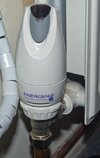- Joined
- 13 Mar 2019
- Messages
- 932
- Reaction score
- 242
- Country

What in the one room are you heating? I heat myself in my home office with a heated blanket - 40W max.

I know gas is cheaper but am not going to turn off 15 rads at night and 15 rads on next day every time. They are balanced rads so hassle and possible mistakes.
I am comparing 22KW boiler to heat 16 rads when one room is used against a 1KW electric heater. 1KW electric heater will cost max 34p/hr and boiler will cost over £1/hr, with today capped prices.
Anyways, after further consideration, my choice is wall mounted oil rad.

I have theseI know gas is cheaper but am not going to turn off 15 rads at night and 15 rads on next day every time. They are balanced rads so hassle and possible mistakes.
I am comparing 22KW boiler to heat 16 rads when one room is used against a 1KW electric heater. 1KW electric heater will cost max 34p/hr and boiler will cost over £1/hr, with today capped prices.
Anyways, after further consideration, my choice is wall mounted oil rad.
 have the option for geofencing, as does my wall thermostat (unfortunately they don't talk to each other) but as will many central heating devices some are better than others, Drayton wiser TRV works out time to heat the room, so you set time you want it warm by, and it works out when to switch on, my cheap Energenie MiHome TRV's have OTT anti hysteresis so the geofencing does not really work, and my Nest Gen 3 does not allow the distance to be set, only the Eco and Comfort temperatures.
have the option for geofencing, as does my wall thermostat (unfortunately they don't talk to each other) but as will many central heating devices some are better than others, Drayton wiser TRV works out time to heat the room, so you set time you want it warm by, and it works out when to switch on, my cheap Energenie MiHome TRV's have OTT anti hysteresis so the geofencing does not really work, and my Nest Gen 3 does not allow the distance to be set, only the Eco and Comfort temperatures.
It entirely depends on the circumstances. I sit at my desk most of the day, and cool down as I am not particularly active. When I'm in other parts of the house, I am moving around, so don't feel the need for heating. Other seasons and combinations of people in the house require other combinations of central and local heating, as appropriate.It has already been said, an electric blanket could keep one warm, but why bother even with an electric blanket, just a blanket would do the same, but the whole idea of central heating is we can get up and walk from room to room without wearing out door cloths
What do you read into this:
"
Do panel heaters use a lot of electricity?
Panel heaters are less efficient than electric radiators because convected heat is inherently less efficient than radiated heat. This means that you'll need to use more power to heat your room with panel heaters than you would with energy efficient electric radiators.
"
Well, almostAll direct electric heating system are 100% efficient, no more, no less.
Well, almost
A few of these ceramic rads are also marketed as 'smart' - having LCDisplays and WiFi - so you may lose a fraction of a watt on radio waves and light!
Yes, the energy will eventually end up as heat - however, unless fully absorbed, it will not necessarily end up as heat inside the room...The 'fraction of a watt' will end up as heat, so still 100% efficient.

Define efficient. To my mind to heat a room to the temperature required for occupancy unless the room is used 24/7 one takes a ratio of time being heated compared with time being used, so heat for two hours and used for one hour then 50% efficiency.Absolute, total lies... All direct electric heating system are 100% efficient, no more, no less. The only exception are ASHP systems, which exceed 100%

If you need to "heat" just one bedroom (independently of any other domestic heating), the best device is a "Fan Heater"- with this type of design, with a thermostat.Q. Occasionally, I need to heat one bedroom in my house before sleep when alone. I have 16 rads, gas boiler 25KW boiler, surely 1KW (or less) electric heater is more economical than CH. Which type of electric heater shall I buy?

Define efficient. To my mind to heat a room to the temperature required for occupancy unless the room is used 24/7 one takes a ratio of time being heated compared with time being used, so heat for two hours and used for one hour then 50% efficiency.
If you need to find a tradesperson to get your job done, please try our local search below, or if you are doing it yourself you can find suppliers local to you.
Select the supplier or trade you require, enter your location to begin your search.
Are you a trade or supplier? You can create your listing free at DIYnot Local
